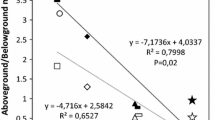Summary
Canopy structure, shoot design, and photosynthetic light recruitment were used to compare four coexisting dwarf shrub species with respect to light utilization. All four species showed different shoot designs which probably result in different light interception properties. Leaves of Vaccinium uliginosum showed the highest levels of photosynthetic light saturation but in situ the shoots of this species reached their maximum photosynthetic rate at the lowest photon flux densities. No consistent differences with respect to photosynthetic light responses were found between deciduous and evergreen species. At sites dominated by one of the deciduous species (Vaccinium uliginosum or V. myrtillus), the two evergreen species studied (V. vitis-idaea and Empetrum hermaphroditum) occurred in the understory, i.e., with their leaf distribution slightly below that of the deciduous species. Sites dominated by one of the evergreen species showed less vertical differentiation in leaf distribution between species.
Similar content being viewed by others
References
Barry RG, Courtin GM, Labine C (1981) Tundra climates. In: Bliss LC, Heal OW and Moore JJ (eds) Tundra ecosystems: A comparative analysis. Cambridge University Press, Cambridge, pp 81–114
Cernusca A (1975) Standörtliche Variabilität in Mikroklima und Energiehaushalt alpiner Zwergstrauchbestände, Verh Ges Ökologie, Wien 1975, pp 9–21
Cernusca A (1976) Bestandesstruktur, Bioklima und Energiehaushalt alpiner Zwergstrauchbestände. Öcol Plant 11:71–102
Field C, Mooney HA (1983) Allocating leaf nitrogen for the maximation of carbon gain: leaf age as a control on the allocation program. Oecologia (Berlin) 56:341–347
Grace J, Marks TC (1978) Physiological aspects of bog production at Moore House. In: Heal OW, Perkins DF (eds) Production ecology of British moors and montane grasslands. Ecol stud, vol 27. Springer, Berlin, pp 38–51
Karlsson PS (1982) Ecology of a deciduous and an evergreen dwarf shrub: Vaccinium uliginosum and Vaccinium vitis-idaea in subarctic Fennoscandia. Ph D Thesis, University of Lund
Karlsson PS (1985a) Photosynthetic characteristics and leaf carbon economy of a deciduous and an evergreen dwarf shrub: Vaccinium uliginosum L. and V. vitis-ideea L. Holarct Ecol 8:9–17
Karlsson PS (1985b) Patterns of carbon allocation above ground in a deciduous (Vaccinium uliginosum) and an evergreen (Vaccinium vitis-idaea) dwarf shrub. Physiol Plant 63:1–7
Karlsson PS (1985c) Effects of water and mineral nutrient supply on a deciduous and an evergreen dwarf shrub: Vaccinium uliginosum L. and V. vitis-idaea L. Holarct Ecol 8:1–8
Karlsson PS (1987) Micro-site performance of evergreen and deciduous dwarf shrubs in a subarctic heath in relation to nitrogen status. Holarct Ecol 10 (in press)
Körner Ch (1982) CO2 Exchange in the alpine sedge Carex curvulata as influenced by canopy structure, light and temperature. Oecologia (Berlin) 53:98–104
Kuroiwa S (1970) Total photosynthesis of a foliage in relation to inclination of leaves. Prediction and Measurement of Photosynthetic Production. Wageningen Centr Agr Publ Doc, pp 79–89
LeDrew EF, Weller G (1978) A comparison of the radiation and energy balance during the growing season for an arctic and alpine tundra, Arct Alp Res 10:665–678
Limbach WE, Oechel WC, Lowell W (1982) Photosynthetic and respiratory responses to temperature and light of three Alaska tundra growth forms. Holarct Ecol 5:150–157
Mooney HA, Gulmon SL (1982) Constraints on leaf structure and function in reference to herbivory. BioScience 32:198–206
Schulze E-D (1982) Plant life forms and their carbon, water and nutrient relations. In: Lange O, Nobel PS, Osmond CB, Ziegler H (eds) Encyclopedia of plant physiology NS, vol 12 B. Springer, Berlin, pp 615–676
Sonesson M, Lundberg B (1974) Late quaternary forest development of the Troneträska area, North Sweden. I. Structure of modern forest ecosystems. Oikos 25:121–133
Sveinbjörnsson B (1983) Bioclimate and its effect on the carbon dioxide flux of mountain birch (Betula pubescens Ehrh.) at its altitudinal tree-line in the Torneträsk area, northern Sweden. Nordicana 47:111–122
Tieszen LL, Lewis MC, Miller PC, Mayo J, Chapin FS III, Oechel W (1981) An analysis of processes of primary production in tundra growth forms. In: Bliss LC, Heal OW, Moore JJ (eds) Tundra ecosystems, a comparative analysis. Cambridge University Press, pp 285–356
Zar JH (1984) Biostatistical analysis. Prentice Hall, Englewood Cliffs
Author information
Authors and Affiliations
Rights and permissions
About this article
Cite this article
Staffan Karlsson, P. Niche differentiation with respect to light utilization among coexisting dwarf shrubs in a subarctic woodland. Polar Biol 8, 35–39 (1987). https://doi.org/10.1007/BF00297162
Received:
Accepted:
Issue Date:
DOI: https://doi.org/10.1007/BF00297162




